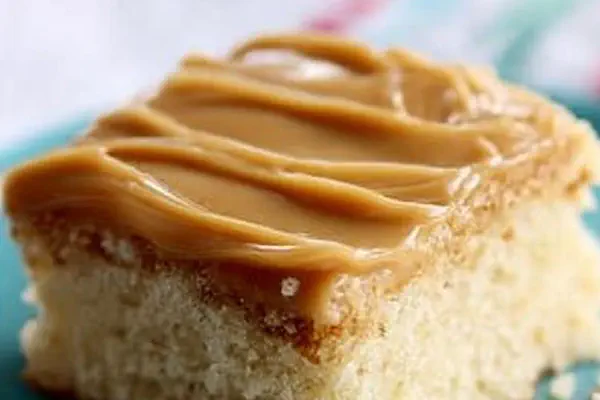Caramel Sheet Cake Twist

By Emma
Certified Culinary Professional
Ingredients
- 1 cup unsalted butter softened
- 1 1/4 cup granulated sugar
- 3 large eggs
- 2 1/2 cups all-purpose flour
- 1 tsp baking powder
- 1/2 tsp kosher salt
- 1 cup whole milk
- 1 tsp vanilla extract
- 1/2 tsp espresso powder (added twist)
For icing===
- 1 1/2 cups packed brown sugar (light or dark)
- 1/4 tsp kosher salt
- 3/4 cup pecan halves (swap for butter, toasted and finely chopped)
- 3/4 cup whole milk
- 1/4 cup unsalted butter
- 2 cups powdered sugar
About the ingredients
Method
Make cake batter first===
- Preheat oven 350F. Spray 9x13 pan with oil spray, avoid heavy coats, prevents soggy edges.
- In mixing bowl, beat butter and sugar 4-6 minutes. Look for lighter color, fluffy texture. Crucial to dissolve sugar partially for crumb structure. Short beats? Dense cake.
- Add eggs one at a time, beat just until mixed to avoid tough cake. Timing here key.
- Mix dry in separate bowl: flour, baking powder, salt, espresso powder. Yes, espresso is subtle but lifts caramel notes.
- Add half dry to butter combo, blend low speed. Add half milk, repeat for rest. Don’t overmix. Gluten activation kills softness.
- Vanilla last, fold in gently. Batter thick, pourable. Scrape sides, uniform batter needed for even rise.
- Pour into pan, spread evenly with offset spatula. Tap pan for air bubbles to rise, evens bake.
- Bake 23-28 min. Watch edges pull from side and surface less shiny but not cracked. Toothpick comes out with moist crumbs, no wet batter. Overbake? Dry, crumbly cake.
- Cool cake fully before icing. Warm cake melts frosting. Patience saves precision.
While cake cools, start caramel icing===
- In small saucepan, combine brown sugar, salt, milk, butter, and toasted chopped pecans instead of butter pieces. Toast pecans in dry pan until nutty aroma, then finely chop. Adds crunch inside frosting, unexpected bite.
- Heat on medium-low, stir constantly. Once bubbles form, boil gently for 2 min to soften sugar crystals and build flavor. Be vigilant. Scorching odors ruin batch, stir steady but gentle.
- Remove from heat, cool COMPLETELY. Hot caramel ruins powdered sugar mix and makes runny disaster.
- After cooling, transfer to stand or hand mixer bowl. Beat with powdered sugar until fluffy. Texture key: add more powdered sugar if runny; few milk drops if stiff. Spreading ease depends on this adjustment.
- Frost cake generously. Use spatula zigzag method for texture, not slick finish. Scattered pecan bits on top add crunch and rustic look.
- Serve at room temp or slightly chilled. Can refrigerate leftover cake wrapped tightly; bring back to room temp before serving for ideal texture and flavor.
Cooking tips
Chef's notes
- 💡 Butter temp matters—too cold, cake dense; room temp soft but not melted. Beat butter and sugar till pale, fluff, partial dissolve sugar for crumb air pockets. Skip short beating = tight crumb. Egg addition slow, one at a time, stop when mixed to avoid tough bonds.
- 💡 Add dry and milk ingredients alternately—half flour mix, half milk, repeat. Stir low speed or mix by hand but avoid overmix. Gluten wakes up fast if overworked. Batter should be pourable yet thick. Use spatula to scrape sides; uneven batter, uneven rise.
- 💡 Watch baking cues not clock. Edges just pulling away, surface dull (not slick shiny) signal near-done. Toothpick comes with moist crumbs, no wet batter or dry crumbs. Overbake equals dry and crumbly cake. Oven temps vary; rely on look and feel.
- 💡 Caramel icing needs patience—toast pecans dry in pan till nutty aroma, chop fine. Combine sugars, milk, butter, pecans in saucepan; medium-low heat, stir constantly. Boil gently exactly 2 minutes to avoid grit or burn flavor. Smell scorch? Lower heat right away.
- 💡 Cool caramel fully to avoid runny frosting. Beat in powdered sugar once cold; add more sugar for stiffness, few milk drops for looseness. Frost with spatula wingspan zigzag strokes for rustic texture, not slick or smooth shiny finish. Pecan bits on top add crunchy contrast.
Common questions
Can I skip espresso powder?
Yes, no coffee notes but subtle flavor loss. Adds depth beyond bitterness—not coffee taste. If none, cake sweeter, less complex. Optional but worth trying at least once.
Pecans allergic alternative?
Use walnuts or skip nuts in frosting. Texture differs. Walnut flavor stronger, adjust sugar if needed. No nuts makes smooth icing, loses crunch contrast but still works.
Cake turned dry?
Likely overbake or overmix. Check oven temps early with toothpick test. Don’t overbeat eggs or flour mix. Moisture balance depends on timing and gentle handling. Rest cake fully before icing; warm cake melts frosting into mess.
Best storage tips?
Wrap cake tight with plastic wrap or foil. Refrigerate if warm climate, cover well to avoid drying. Leftover cake stands covered at room temp up to 2 days. Bring back to room temp before serving for crumb softness and frosting flavor.



